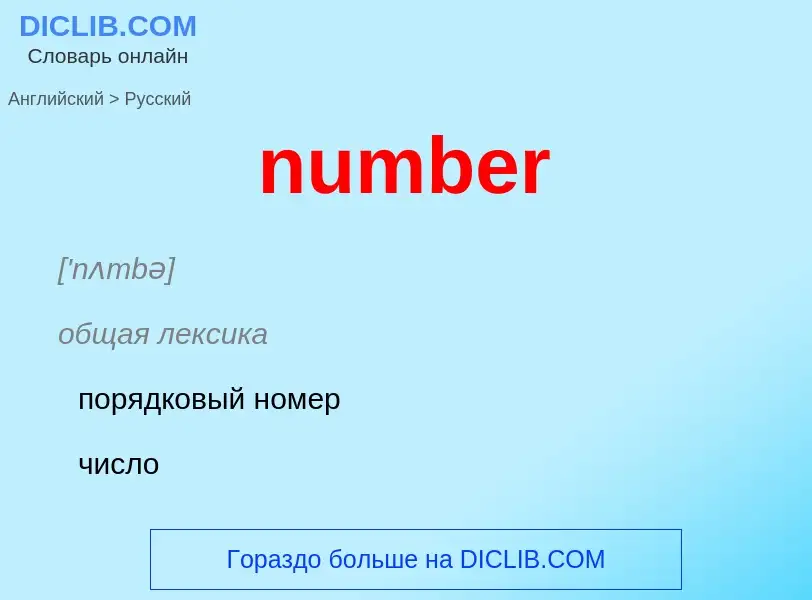Traducción y análisis de palabras por inteligencia artificial
En esta página puede obtener un análisis detallado de una palabra o frase, producido utilizando la mejor tecnología de inteligencia artificial hasta la fecha:
- cómo se usa la palabra
- frecuencia de uso
- se utiliza con más frecuencia en el habla oral o escrita
- opciones de traducción
- ejemplos de uso (varias frases con traducción)
- etimología
number - traducción al ruso
['nʌmbə]
общая лексика
порядковый номер
число
количество
численность
балл
выпуск
занумеровать
занумеровывать
код числа
колонцифра
насчитывать
насчитываться
номер
номерной
нумеровать
перенумеровать
перенумеровывать
подсчитывать
пронумеровать
считать
цифровать
числительное
числовой
строительное дело
количество (в штуках)
существительное
['nʌmbə]
общая лексика
число
количество
некоторое количество
ряд
большое число
масса
(порядковый) номер
номер (дома) (употр. в [сокр.] форме No)
номер
выпуск (издания)
номер программы
выступление
позывные
сумма
цифра
арифметика
военное дело
количество вооружений
разговорное выражение
что-л. выделяющееся
бросающееся в глаза
девушка
девчонка
сленг
наркотик
специальный термин
показатель
музыка
метр
размер
ритм
поэтическое выражение
стихи
синоним
глагол
общая лексика
нумеровать
насчитывать
(among
in
with) причислять
зачислять
числить (кем-л., чем-л.)
военное дело
производить расчёт
книжное выражение
считать
пересчитывать
- access number
- binary number
- check number
- code number
- composite number
- control number
- credit card number
- decimal number
- Fermat number
- identification number
- user identification number
- key number
- licence number
- Lucas number
- message sequence number
- natural number
- non-predictable number
- non-prime number
- personal access number
- personal identifying number
- polindromic number
- provably prime number
- pseudorandom number
- random number
- rational number
- real number
- reciprocal number
- seed number
- smooth number
- transaction sequence number
- true random number
- user identification number
Wikipedia
A number is a mathematical object used to count, measure, and label. The original examples are the natural numbers 1, 2, 3, 4, and so forth. Numbers can be represented in language with number words. More universally, individual numbers can be represented by symbols, called numerals; for example, "5" is a numeral that represents the number five. As only a relatively small number of symbols can be memorized, basic numerals are commonly organized in a numeral system, which is an organized way to represent any number. The most common numeral system is the Hindu–Arabic numeral system, which allows for the representation of any number using a combination of ten fundamental numeric symbols, called digits. In addition to their use in counting and measuring, numerals are often used for labels (as with telephone numbers), for ordering (as with serial numbers), and for codes (as with ISBNs). In common usage, a numeral is not clearly distinguished from the number that it represents.
In mathematics, the notion of a number has been extended over the centuries to include zero (0), negative numbers, rational numbers such as one half , real numbers such as the square root of 2 and π, and complex numbers which extend the real numbers with a square root of −1 (and its combinations with real numbers by adding or subtracting its multiples). Calculations with numbers are done with arithmetical operations, the most familiar being addition, subtraction, multiplication, division, and exponentiation. Their study or usage is called arithmetic, a term which may also refer to number theory, the study of the properties of numbers.
Besides their practical uses, numbers have cultural significance throughout the world. For example, in Western society, the number 13 is often regarded as unlucky, and "a million" may signify "a lot" rather than an exact quantity. Though it is now regarded as pseudoscience, belief in a mystical significance of numbers, known as numerology, permeated ancient and medieval thought. Numerology heavily influenced the development of Greek mathematics, stimulating the investigation of many problems in number theory which are still of interest today.
During the 19th century, mathematicians began to develop many different abstractions which share certain properties of numbers, and may be seen as extending the concept. Among the first were the hypercomplex numbers, which consist of various extensions or modifications of the complex number system. In modern mathematics, number systems are considered important special examples of more general algebraic structures such as rings and fields, and the application of the term "number" is a matter of convention, without fundamental significance.

![The number 605 in [[Khmer numerals]], from an inscription from 683 AD. Early use of zero as a decimal figure. The number 605 in [[Khmer numerals]], from an inscription from 683 AD. Early use of zero as a decimal figure.](https://commons.wikimedia.org/wiki/Special:FilePath/Khmer Numerals - 605 from the Sambor inscriptions.jpg?width=200)
